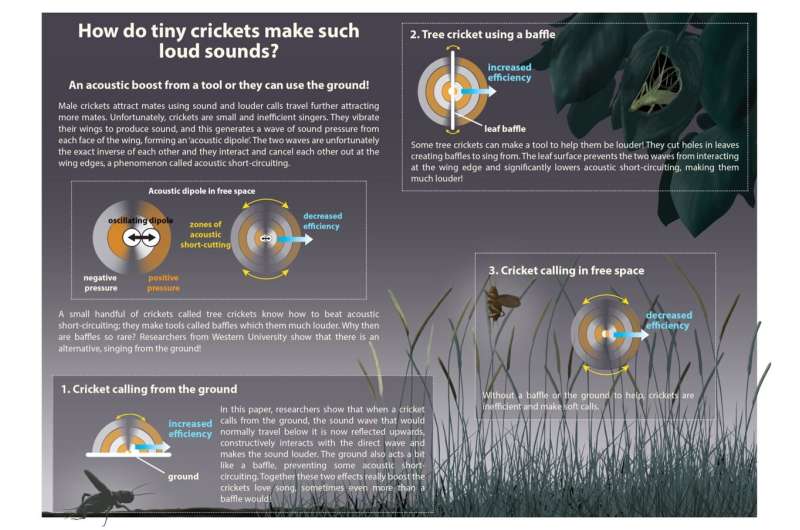This article has been reviewed according to Science X's editorial process and policies. Editors have highlighted the following attributes while ensuring the content's credibility:
fact-checked
peer-reviewed publication
trusted source
proofread
Study shows animals like crickets use the ground to amplify calls

When animals "sing" sitting on the ground—such as when crickets chirp—their volume and reach increase dramatically, by as much as ten-fold. This result from a study by Western researchers, published today in the journal PNAS, contradicts long-held beliefs in the field of animal communication, which presume the ground is a hindrance to sound transmission.
"Crickets are a great test case for understanding how communication evolves in animals because there are so many of them," said study lead author Erin Brandt, a former postdoctoral associate in Western's department of biology. "They're spread out across this gigantic evolutionary tree, and they use different strategies to maximize the efficiencies of their calls."
Crickets use their wings to make calls or "chirps" to attract mates. A few species of crickets, such as tree crickets, even build tools known as baffles (by carving out holes in leaves) to help them be louder.
To better understand this natural phenomenon, Brandt and a team led by Natasha Mhatre, Canada Research Chair in invertebrate neurobiology, designed computer models that simulated different crickets singing. The models spanned their entire natural size and frequency range, which the researchers measured from the wings and songs of more than a hundred species of crickets, painstakingly collecting data from papers, museum specimens and online databases.
With the baseline established, Mhatre, Brandt and undergraduate students Sarah Duke and Honglin Wang next tested whether adding the acoustic tool, the baffle, increased the efficiency of the songs for ground crickets. They found that yes, all crickets could benefit from baffles.
But if that's the case, and using tools like baffles is so advantageous, why don't more of the 6,000 plus species of crickets use them?
"We thought there was something about the environment they sang in that made tools a good option only for the few species who use them," said Brandt.
To delve deeper, the researchers re-modeled their computer-generated environments more realistically, by adding elements like the ground and vegetation. To their surprise, they discovered when animals sang sitting on land, their acoustic efficiency (volume and reach) could increase more than 10 times the regular returns.
"What we learn from crickets is that if you are going to be small and efficient at making sound, you can get a heck of a lot louder by being near the ground," said Mhatre. "Don't put your speaker up in the trees. If you want to be loud, put iton the ground, and you're actually going to do better."
By exploring the literature on acoustics more deeply, they discovered it's not just crickets that can benefit from using the ground as an amplifier. Wolves, howler monkeys, frogs, even the tiny cicada would produce louder calls if they integrated the ground (or another relatively flat surface, like water or a tree trunk) into their communication strategy.
This principle of considering the relationship between singing effort to sound output has been missing in previous animal acoustic research, say the researchers, so some basic bioacoustics theories may need to change.
"The physics says what we discovered about crickets should hold true for all animals. This study has the potential to make us rework textbooks about animal communication," said Brandt, now a postdoctoral scholar at University of Chicago.
Mhatre, a leading world expert in tree crickets and acoustic communication, is also excited about what the study shows about tool use in the animal kingdom.
"There is an overriding hypothesis that has existed as long as we have studied animal tools. It says tools don't really provide great utility for animals, and so they are uncommon," said Mhatre. "But here is a study where we could take a tool and put a number on exactly how much it yields and really test this hypothesis. It turns out they are useful, but there's more than one way to be loud."
More information: Erin E. Brandt et al, The ground offers acoustic efficiency gains for crickets and other calling animals, Proceedings of the National Academy of Sciences (2023). DOI: 10.1073/pnas.2302814120
Journal information: Proceedings of the National Academy of Sciences
Provided by University of Western Ontario


















